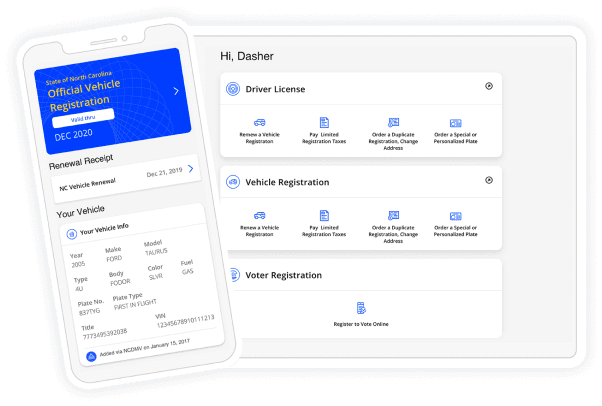The U.S. has 228.2 million licensed drivers, accounting for 89% of the population over 18 years of age, according to the latest statistics from the Federal Highway Administration. That means that Department of Motor Vehicles (DMV) services are high in demand, making them a prime focus for government digital transformation. DMV digitalization helps to reduce walk-in traffic and accelerate service delivery.
Here are some of the key takeaways:
- Online DVM solutions can help agencies leverage a digital government strategy.
- Motor vehicle online services improve the citizen experience and trust in government.
- DMV online payment enables agencies to streamline operations and increase revenue.
DMV services online simplify doing business with the government
DMV offices traditionally see a high volume of customers because motor vehicle services are essential in the public sector. A DMV self-service solution can help agencies reduce walk-in traffic and wait times, accelerating service delivery. The demand for contactless solutions has increased with the COVID-19 pandemic, but digital government trends are here to stay.
Improving and digitizing citizen experience is a top priority for state chief information officers (CIOs) in 2022, behind only cybersecurity, per state CIOs surveyed by NASCIO. Considering that governments can quickly realize their return on investment (ROI) by cutting down expenses associated with document and payment processing, it’s no wonder vehicle registrations and driver’s license renewals are among the key services to modernize as part of a digital government transformation strategy.
DMV online transactions bring convenience for residents
Allowing residents to complete transactions online is the top way to improve DMV customer service, according to a majority of respondents in an iProof study. DMV online transactions accelerate service delivery because residents can interact with their agencies anytime and anywhere.
Not all residents can afford to spend time in a government building to pay a bill or renew a driver’s license. A trip to the DMV office might require taking time off work or making childcare arrangements. Simplifying government services and payments with an online DMV experience makes them more accessible.
PayIt was born out of this desire to improve DMV online services. PayIt cofounder John Thomson found himself sitting at a local DMV office after not being able to renew his vehicle registration through the internet. The experience sparked the idea of building a modern, convenient and connected solution for residents doing business with governments. Today, PayIt’s award-winning SaaS platform digitizes DMV payments and many other public services, from licenses to utility bills.
Here are some of the DMV services that PayIt can digitize:
- Renewals of driver’s licenses, ID cards and vehicle registrations
- Property tax payments on registration plates
- Personalized and specialty license plate orders
- Duplicate licenses orders
- Change of address
- Paperless reminders of due dates

Benefits of DMV self-service
Enabling residents to pay for DMV services online brings the following benefits to government agencies:
1. Higher resident trust in the public sector
Backlogs, outdated legacy systems and long wait times contribute to a negative perception of local DMVs as inefficient rather than trusted service providers. A modern DMV solution can enhance the perception of the public sector because it brings governments and residents closer together.
A Deloitte study shows that effective digital services influence the level of public trust in government agencies. There’s a higher level of trust in local governments because residents interact with agencies more directly, from reporting a pothole to renewing a driver’s license. At the federal level, though, residents are more removed from the process.
2. Operational efficiency and savings
A DMV automated system can give agencies quick wins in operational efficiency. For example, online processes free up employee time from supporting walk-in customers and reduce waiting times. According to Forrester’s Total Economic Impact of deploying PayIt, enhanced productivity thanks to reduced walk-in efforts can lead to $75,991 in savings per 100,000 transactions. Forrester’s TEI study also noted that agencies save more than they spend when they digitize their processes, realizing a 322% return on investment (ROI) over a three-year period.
- For employees, reduced manual tasks and customer issues help improve morale.
- For residents, the convenience and the speed of 24/7 service delivery make everyday life easier.
- For governments, that’s an opportunity to improve both citizen experience and employee experience at the same time. As the Gartner Predicts 2022 report notes, “Governments that continue to focus on improving citizen and employee experiences separately will miss out on synergies between the two that can lead to substantial improvements in both areas.”
3. Better integration across data silos
With manual processes, residents have to fill out forms by hand at their local DMV office, and then a government employee has to enter the data into the system. When residents can fill out and submit forms online, the data is automatically updated across department silos, too.
One of the advantages of a government platform such as PayIt is scalability. Agencies can add more services and features, breaking down data silos. Building on trends of accelerated digital government and seamless service delivery, data sharing is now a priority, according to Deloitte’s Government Trends 2022 report.
4. Expanded revenue opportunities
Nine out of ten respondents in an iProof’s study are willing to pay an additional fee to renew their driver’s license online. The survey also reveals that 31% of the respondents have admittedly driven with an expired license to avoid going to a DVM office to renew it. When residents delay in-person appointments, governments lose out on revenue.
The experience of PayIt’s clients shows that DMV digital solutions help boost online revenue. In the case of North Carolina, there’s a 14% increase in online revenue year-over-year (2021 vs. 2020).
Launched in 2018, myNCDMV has transformed the way residents of North Carolina interact with their government. Since launch, there have been roughly 10.6 million digital vehicle registration renewals, contributing to a 40% decrease in DMV office wait time for the North Carolina Department of Transportation (NCDOT).
5. Increased government resilience
Digital solutions for DMV transactions empower governments to adapt to changes and respond to disruptions more quickly. Building more resilient government operations has become more crucial than ever due to:
- The COVID-19 pandemic. Lockdowns increased the demand for contactless customer service and drove the adoption of digital services and electronic payments to meet the needs of residents 24/7, wherever they are.
- New federal requirements such as Real ID. The federal law—with its deadline extended to May 2023—will require the use of a valid passport or REAL ID document to board flights within the U.S. Residents can get a real ID enhancement for their driver’s license or ID card at DMV offices. With myNCDMV, for example, users can renew or order a duplicate for a REAL ID online.
Pave the way to digital government transformation with PayIt
Take the next step toward improved DMV payments online. Learn how to leverage PayIt software for government agencies to boost online revenue and make motor vehicle services more efficient. Book a demo now.
